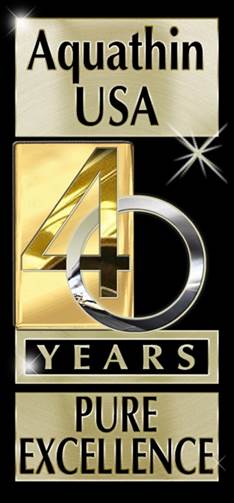DEIONIZATION
DEIONIZATION
The Aquathin Reverse Osmosis Element has the ability to reject (92+% to 97+%, CTA style vs. TFC style @ 60F-70F @ 60-70psi) of the dissolved inorganics in water. Rejection is based on the degree of removal of Na+ and Cl-. Although the RO has a higher percentage of removal of di, tri and quatrovalenced elements (i.e. 99% Al), the monovalenced elements are rejected at the percentages referenced above. The Aquathin Patented RO Process also removes disease causing waterborne microorganisms.
RO is not as efficient (only about 50%-65%) for nitrates, nitrites and VOCs (volatile organic chemicals i.e. hydrocarbons such as benzene, ethylene, toluene, zylene, MTBE ). The nominal 8% or less of dissolved solids, mostly monovalent, and balance of any other inorganic and organic contaminates enter the four staged Aquathin Deionization Module. The DI resin is a manmade plastic bead that is chemically made anionic (OH-) and cationic (H+). This is a superior "nuclear grade" resin as opposed to the industrial type of cationic resin (Na+) that is utilized in a water softener. In a water softener a substitution reaction occurs whereby Na+ is exchanged for Ca++ and Mg++ at a 2:1 ration. In the proprietary Aquathin DI Module that is specially produced to compliment the Aquathin RO Membrane, H+ and OH- are exchanged for the monovalenced elements in the RO permeate. Therefore, all the Aquathin System puts into the water is H+OH- or H20.
The last three inches of the DI Module is granulated activated carbon (GAC), the same high quality adsorptive carbon made use of in the Aquathin MegaChar Total Home Filter. Its purpose is to enhance what some term a flat taste and to remove any organic that may appear in trace form from a partial degree of removal via the RODI processes. To date we know of no such organic that is not rejected by the RO and / or bond is broken and force into radical state and subsequently exchanged (substituted), or adsorbed in the DI Module. At that point the GAC participates as a failsafe for organic removal. The RODI water finally passes a .2 micron pad for backup bacterial protection in the unlikely event a membrane could rupture and simultaneously serves to prevent reverse migration of contaminates.
For More Information About Aquathin, click
https://www.facebook.com/aquathin/
https://www.linkedin.com/in/alfielipshultz/


